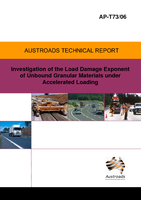Pavement

Investigation of the Load Damage Exponent of Unbound Granular Materials Under Accelerated Loading
- Publication no: AP-T73-06
- ISBN: 1 921139 82 X
- Published: 20 December 2006
- PDF (free) Download
This report details the experimental program, analysis and findings of the assessment of the impacts of axle mass increases on road deterioration for sprayed seal surfaced unbound granular pavements. Load-damage exponents ranged between two and four (based on surface deformation) and three to five (based on roughness progression). Overall it was considered that the 4th power law (LDE = 4) was adequate for the types of pavements studied and under the test conditions; however, this value may be conservative in some instances and not in others. The relative performance factors developed ranged between two and eight depending on the extent of axle load increase and the material type. These factors would be useful in the development and refinement of network pavement deterioration models. There were a number of limitations associated with the study and further research is needed if a wider range of material and environmental conditions are to be examined and alternative analysis methods for the estimation of roughness progression developed.
- AP-T73/06 INVESTIGATION OF THE LOAD DAMAGE EXPONENT OF UNBOUND GRANULAR MATERIALS UNDER ACCELERATED LOADING
- SUMMARY
- CONTENTS
- TABLES
- FIGURES
- 1. INTRODUCTION
- 2. BACKGROUND
- 3. THE ACCELERATED LOADING FACILITY (ALF)
- 3.1. Description of ALF
- 4. EXPERIMENTAL DESIGN
- 4.1. Test pavements
- 4.2. Test pavement uniformity
- 5. ACCELERATED LOADING TEST PROGRAM
- 5.1. Pavement bedding-in
- 5.2. Lateral distribution to simulate traffic wander
- 5.3. Summary of accelerated loading applied using the ALF
- 6. PAVEMENT PERFORMANCE ASSESSMENT DURINGACCELERATED LOAD TRAFFICKING
- 6.1. Pavement deflection
- 6.2. Surface deformation
- 6.3. Roughness
- 6.4. Sand patch texture depth
- 6.5. Changes in density after bedding-in
- 7. OBSERVED PAVEMENT PERFORMANCE UNDERACCELERATED LOADING
- 7.1. Pavement deflection
- 7.2. Surface deformation
- 7.3. Roughness
- 7.4. Sand patch texture depth
- 7.5. Change in density after bedding-in
- 8. ANALYSIS OF DEFORMATION AND ROUGHNESSRESULTS
- 8.1. Deformation
- 8.2. Roughness
- 8.3. Summary of analysis
- 9. RELATIVE PERFORMANCE FACTORS FOR INCREASEDAXLE MASS LOADING
- 9.1. General
- 9.2. Relative performance factors for deformation
- 9.3. Relative performance factors for roughness
- 9.4. Summary of implied assumptions for relative performance factors
- 10. ESTIMATION OF LOAD-DAMAGE EXPONENTS
- 10.1. Results of LDE estimation
- 10.2. Summary of implied assumptions for LDE estimation
- 10.3. Alternative method for estimation of load damage exponents
- 11. EFFECT OF INCREASED AXLE LOADS ON PAVEMENTPERFORMANCE
- 11.1. Deformation
- 11.2. Roughness
- 12. STUDY LIMITATIONS AND FURTHER RESEARCH
- 12.1. Limitations of dataset and analysis
- 12.2. Further research
- 13. SUMMARY AND CONCLUSIONS
- REFERENCES
- APPENDIX A PAVEMENT DEFLECTION AND ADJUSTEDSTRUCTURAL NUMBER
- APPENDIX B ESTIMATED LONGITUDINAL PROFILE,DEFORMATION AND ROUGHNESS
- APPENDIX C SURFACE TEXTURE BY SAND PATCH
- APPENDIX D DENSITY AND MOISTURE DATA FOR THEBASE LAYER
- APPENDIX E ALTERNATIVE ANALYSIS TO DETERMINELOAD DAMAGE EXPONENTS (LDE)
- INFORMATION RETRIEVAL
Related publications
AP-PWT00-23
WEB-PROJECTS-23
Latest Pavement News
